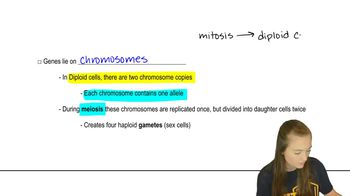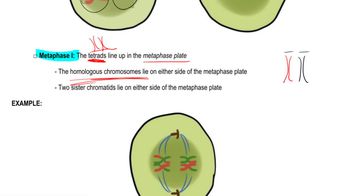Are the four daughter cells produced from meiosis II diploid or haploid?
Table of contents
- 1. Introduction to Genetics51m
- 2. Mendel's Laws of Inheritance3h 37m
- 3. Extensions to Mendelian Inheritance2h 41m
- 4. Genetic Mapping and Linkage2h 28m
- 5. Genetics of Bacteria and Viruses1h 21m
- 6. Chromosomal Variation1h 48m
- 7. DNA and Chromosome Structure56m
- 8. DNA Replication1h 10m
- 9. Mitosis and Meiosis1h 34m
- 10. Transcription1h 0m
- 11. Translation58m
- 12. Gene Regulation in Prokaryotes1h 19m
- 13. Gene Regulation in Eukaryotes44m
- 14. Genetic Control of Development44m
- 15. Genomes and Genomics1h 50m
- 16. Transposable Elements47m
- 17. Mutation, Repair, and Recombination1h 6m
- 18. Molecular Genetic Tools19m
- 19. Cancer Genetics29m
- 20. Quantitative Genetics1h 26m
- 21. Population Genetics50m
- 22. Evolutionary Genetics29m
9. Mitosis and Meiosis
Meiosis
Problem 2f
Textbook Question
Our closest primate relative, the chimpanzee, has a diploid number of 2n = 48. For each of the following stages of M phase, identify the number of chromosomes present in each cell.
Early prophase I
 Verified step by step guidance
Verified step by step guidance1
Understand the diploid number (2n) of the organism: The diploid number for chimpanzees is given as 2n = 48. This means that in a diploid cell, there are 48 chromosomes, or 24 homologous pairs of chromosomes.
Recall the stage of meiosis being discussed: Early prophase I is the first stage of meiosis I, where homologous chromosomes begin to condense and pair up. At this stage, the cell is still diploid, and no division has occurred yet.
Determine the number of chromosomes in early prophase I: Since the cell is diploid at this stage, the number of chromosomes remains the same as the diploid number, which is 48 chromosomes.
Clarify the state of the chromosomes: Each chromosome at this stage has already undergone DNA replication during the S phase of the cell cycle. Therefore, each chromosome consists of two sister chromatids, but the chromosome count is still based on centromeres, not chromatids.
Conclude the chromosome count: In early prophase I, the number of chromosomes in the cell is 48, as no division or separation of homologous chromosomes has occurred yet.
 Verified video answer for a similar problem:
Verified video answer for a similar problem:This video solution was recommended by our tutors as helpful for the problem above
Video duration:
1mPlay a video:
Was this helpful?
Key Concepts
Here are the essential concepts you must grasp in order to answer the question correctly.
Diploid Number
The diploid number (2n) refers to the total number of chromosomes in a somatic cell, where chromosomes exist in pairs. In the case of chimpanzees, the diploid number is 48, meaning there are 24 pairs of homologous chromosomes. This concept is crucial for understanding how chromosomes are organized and distributed during cell division.
Recommended video:
Guided course

Diploid Genetics
M Phase of Cell Cycle
M Phase, or mitotic phase, is the stage of the cell cycle where cell division occurs, including both mitosis and cytokinesis. During this phase, the cell's chromosomes condense and become visible under a microscope. Understanding M Phase is essential for determining the number of chromosomes present at various stages of cell division, such as prophase.
Recommended video:
Guided course

Bacteriophage Life Cycle
Prophase I of Meiosis
Prophase I is the first stage of meiosis, where homologous chromosomes pair up and exchange genetic material through a process called crossing over. In this stage, the diploid number of chromosomes is still present, but they are organized into tetrads (pairs of homologous chromosomes). For chimpanzees, this means that during early prophase I, there are still 48 chromosomes, but they are in a paired configuration.
Recommended video:
Guided course

Meiosis Steps
Related Videos
Related Practice
Multiple Choice
564
views
2
rank


